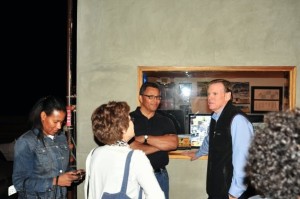
PART THREE – OPERATION ASTROTURF
Boeing efforts to subvert Rocketdyne cleanup result in the establishment of a new Community Advisory Group
“Astroturfing” is a practice used by industry to create the appearance of grassroots community support for its agenda. Public relations firm hired to astroturf often refer to the manufactured supporters as “third parties.”
Part One of Boeing’s Meltdown Makeover, Greenwashing Rocketdyne, exposed Boeing’s plan to “multiply allies and grow their stature.”
The plan stated that, “Third parties who endorse Boeing’s vision for open space at the SSFL site will be key to the media relations campaign. Third parties add credibility and authenticity and blunt allegations of green-washing. Journalists will look to third parties to truth-check the company’s message.”
John Stauber and Sheldon Rampton described this process in their 2002 book, Trust Us We’re Experts: How Industry Manipulates Science and Gambles with Your Future, “Public relations firms and corporations have seized upon a slick new way of getting you to buy what they have to sell: Let you hear it from a neutral “third party,” like a professor or a pediatrician or a soccer mom or a watchdog group. The problem is, these third parties are usually anything but neutral. They have been handpicked, cultivated, and meticulously packaged to make you believe what they have to say.”
Boeing is no stranger to astroturfing. In September 2011, the San Antonio Current newspaper published a story which showed just how handsomely the practice can pay off. According to the paper, in 2007 a Boeing lobbyist offered the American GI Forum a possible “long-term relationship” which would include resources for its office and activities in exchange for the organization’s support for a multi-billion dollar tanker contract with the U.S. Air Force. Boeing was awarded the $35 billion Pentagon contract in February 2012.
Residents of Hinkley California, site of a massive chromium-6 groundwater plume made famous by the film Erin Brockovich, have accused Pacific Gas & Electric of astroturfing through a Community Advisor Committee (CAC). Two years ago the CAC was created by PG&E, which caused the Cr-6 pollution in the first place. Now community members want PG&E out of the CAC because of its control of monthly meetings from determining the agenda to who can speak.
Stifling dissent toward polluting practices can go beyond front groups and “third party” allies. Last year, Marcellus Shale gas drilling spokesmen admitted to using military “psy-ops” or psychological operations to deal with Pennsylvania communities opposed to fracking, the controversial practice of using million of gallons of water infused with hundreds of chemicals, radionuclides, and fine sand to blast subsurface shale to extract natural gas.
A local resident described the industry’s strategy as one that used misinformation, intimidation, “informational meetings” that omitted the negatives from shale gas development, and threats of lawsuits toward anyone who got in the way.
Longtime activists dedicated to the cleanup of the Santa Susan Field Laboratory say these are precisely the tactics that have been employed against them, all aimed at further Boeing’s goal of not cleaning up the high contaminated site.
THE SSFL COMMUNITY
A look at the history of the first people to find out about Rocketdyne’s nuclear and chemical contamination reveals individuals whose lives were forever changed by SSFL and the battle to clean it up. It was documented to the right in an Emmy-award winning CBS-2/KCAL-9 segment “Simi Valley Moms Work to Cleanup Radioactive Neighborhood.” Each one of these women is a cancer survivor.That a group of people can accomplish as much as they have in 23 years makes it clear why Boeing might go to such lengths to replace them with pliant “third parties.”
They were regular folks leading regular lives in the bucolic hills that rise above Simi Valley. Centuries old valley oaks covered the rolling land. People had their own horses and water wells in this cozy neighborhood in the southeast corner of Simi Valley, the Santa Susana Knolls.
People from ‘the Knolls,’ and across Simi Valley knew something was going on at the semi-secret site up Black Canyon Drive on top of the road. The roar of rockets lit up the mountains above the Knolls but folks stayed tight lipped. Some of their dads worked up on the hill at Rocketdyne.
That all changed May 19, 1989 when a Los Angeles Daily News headline blared “Rockwell Site Contaminated.” Four neighbors, Holly Huff, Barbara Johnson, Dawn Kowalski and Marie Mason, couldn’t believe what they had read. The women weren’t even aware that Rocketdyne was doing nuclear work at the lab two miles uphill from their homes. Their phones began to ring off the hook with panicked neighbors.
The Simi Valley moms soon met with a San Fernando homeowners association and environmental groups in Northridge, all of whom were determined to learn more. “We were now not alone but flanked by seasoned activists who could assist us on our mission,” the women wrote in their 2006 autobiographical story Loss of Innocence.
The group founded Rocketdyne Cleanup Coalition (RCC) in June 1989 to fight the relicensing of nuclear work at the lab. The nuclear part of the Santa Susana Field Laboratory – Area IV – is spread out over 270 acres. The Department of Energy had ten experimental reactors and a plutonium fuel fabrication facility on 90 of them.
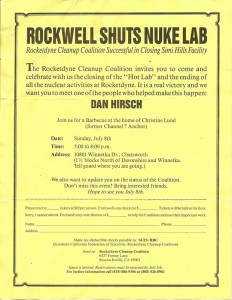 RCC, along with key players and organizations, succeeded in getting the license denied. This was “the first community-based shutdown of a DOE nuclear facility in the country,” according to the RCC website.
RCC, along with key players and organizations, succeeded in getting the license denied. This was “the first community-based shutdown of a DOE nuclear facility in the country,” according to the RCC website.
Dan Hirsch, president of the nuclear watchdog group Committee to Bridge the Gap and nuclear policy lecturer at the University of California, was key to RCC’s historic victory. Hirsch became aware of Rocketdyne in 1979 when two of his students at UCLA uncovered an obscure press release that hinted at a partial meltdown at the lab in 1959.
Discovering the SRE meltdown and helping stop the DOE Rocketdyne relicensing is one in a long line of Hirsch accomplishments, which an invitation to CBG’s 40th anniversary celebration summarized:
“Committee to Bridge the Gap contributed to the shutdown of the UCLA reactor, the Dept. of Energy’s Santa Susana Field Laboratory and Hanford N reactor (and thereby, U.S. plutonium production for nuclear weapons); the international ban on dumping radioactive waste in the ocean; stopping the plans for orbiting nuclear reactors and bombs for “Star Wars”; blocking the proposed Ward Valley nuclear waste dump near the Colorado River; the removal of significant amounts of weapons-grade uranium from places where it could readily be stolen and tightening of security against terrorist attack at nuclear reactors.”
Hirsch also exposed a biomedical nuclear waste dump in Brentwood on Veterans Administration property that was later prevented from development, and he continues to work on highlighting dangers at the San Onofre Nuclear Generating Station. Such is Hirsch’s knowledge about nuclear issues that he has testified before the U.S. Senate about nuclear power using SSFL’s woeful safety record as a cautionary tale.
However, since Hirsch’s work to protect public health usually involves thwarting the plans of large corporate and government entities, he has developed many powerful, well-resourced enemies along the way. “To his supporters, he is a reserved hero, fluent in the language of policy and science. To those he challenges, he seems more like a bombastic, exasperating thorn in the side,” stated a 2008 profile on Hirsch in the Ventura County Star.
And, no where was this more evident than in the SSFL Inter-Agency Work Group meetings. The quarterly meetings were established in 1990 at the urging of Congressman Elton Gallegly to keep the community, legislators and media informed about SSFL. The Work Group panel was composed of government agencies, community representatives, and environmental advocacy groups including Hirsch’s CBG.
Time and again, Hirsch would cut through cleanup-evading language and presentations of agencies and responsible parties – the polluters – calling them on their misinformation and sleights of hand. Such exchanges were crucial to the community’s understanding of the cleanup, as Hirsch was also able to break down complex technical information in a way that the public and media in attendance could comprehend. This made Hirsch, and the Work Group, a polluter’s nightmare.
The Work Group meetings at the Simi Valley Cultural Center were regularly attended by local residents and the growing number of SSFL activists. Longtime activists were delighted to see new faces who could join in their seemingly never-ending struggle to clean up the site. The effort was made stronger and richer by people like Bonnie Klea, who used to work at SSFL and made it her life’s mission to aid former Department of Energy workers and subcontractors from Area IV who were made ill from working there.
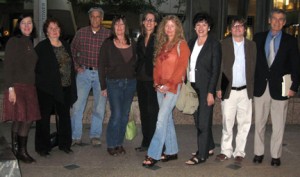
Together, the community worked with state legislators to achieve the passage of SB 990 in 2007, a law to cleanup SSFL to the highest standards. It was a crowning accomplishment that involved the efforts of activists old and new.
For Boeing, that was the last straw. It had enough, and began working a plan to tear out the grassroots of the neighborhoods around SSFL and “astroturf” them with a cadre of people willing to do its bidding. This would also mean getting rid of the SSFL Interagency Work Group and replacing it with a community group more sympathetic to it’s cause.
All the company and its government allies had to do was look for susceptible individuals with ego-driven motives who yearned to feel important and influential. With some attention and coaching, these community members could become the “third-party” allies that Polakovic’s Boeing plan say are necessary to “blunt allegations of greenwashing.”
OPERATION ASTROTURF
When William Preston Bowling opened the Aerospace Cancer Museum of Education (ACME) May 13, 2008, he offered West Hills resident and founder of CleanUpRocketdyne.org, Christina Walsh, an irresistible partnership: a fully functioning facility that would be unlike any other museum in the world. Walsh jumped at the chance. Soon community meetings were taking place at the Southwest-styled building that once was a yoga studio along Valley Circle West. Under the direction of Bowling and Walsh, ACME promised to serve an important role in educating the community on SSFL’s past as well as current cleanup efforts.
Walsh had first came to this reporter’s attention in 2004 at a celebration of Rocketdyne-adjacent Ahmanson Ranch collapsing under the weight of perchlorate revelations. That land, even larger than SSFL in area, became state park land instead of the huge development that now-defunct Washington Mutual had fought for.
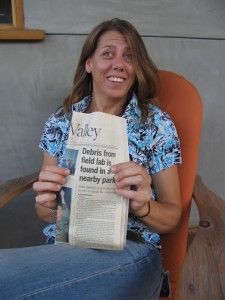 Walsh received praise from many quarters including this reporter. “Her expertise and ability to crunch numbers, analyze data, and conceptualize how it all stacks up in the grand scheme of things are remarkable,” I wrote in an August 20, 2009 EnviroReporter.com post entitled Cleanup Rocketdyne Runkle Canyon Comments. “Walsh has taken much of the work out of analyzing this information herself.”
Walsh received praise from many quarters including this reporter. “Her expertise and ability to crunch numbers, analyze data, and conceptualize how it all stacks up in the grand scheme of things are remarkable,” I wrote in an August 20, 2009 EnviroReporter.com post entitled Cleanup Rocketdyne Runkle Canyon Comments. “Walsh has taken much of the work out of analyzing this information herself.”
What I hadn’t fully realized at the time is that Walsh was already prone to ruthless behavior. Her success at ACME had only fueled her zeal, need for recognition, and relationships with polluters and compromised government staff – all of which made her a perfect target for Boeing’s plan to undercut Hirsch and the Work Group and in effect replace the community.
On August 27, 2009, Boeing Environmental Communications’ Kamara Noelle Sams wrote Walsh and Bowling asking “[D]o you have some time to sit down with Tom Gallacher,” according to an e-mail obtained by EnviroReporter.com. “He’d like to update you on our status as it relates to the Consent Order. Please let me know.”
Gallacher is Director of Safety, Health and Environmental Affairs for Boeing at SSFL. On August 16, 2007, DOE, NASA and Boeing entered into a Consent Order for Corrective Action with DTSC, reads the DTSC draft consent order. It required that these three parties responsible for the contamination at the site “submit a corrective action schedule, and to take other steps necessary to complete the cleanup of all surficial media by June 30, 2017.”
Three days after Sams’ e-mail, it’s clear that Walsh and Gallacher did in fact meet. “Thank you for our recent meeting/discussion,” Walsh wrote Gallacher in an August 30 e-mail. “We have been doing a lot of thinking and have requested a cag. We will need support on this, and I hope you still mean it when you said you would fund a cag.”
A CAG was not needed – the SSFL Interagency Work Group had been an effective vehicle for public participation for over 20 years. But the Work Group members wanted SSFL cleaned up to strict standards, and Boeing did not. A replacement group was required, and an SSFL CAG would do just the trick. This was, and is, classic astroturfing.
“In the Summer of 2009, without my knowledge, Christina Walsh, founder of CleanupRocketdyne.org, accepts a meeting with The Boeing Co. then asks me to ‘Tag Along’ for ‘Support,” Bowling told EnviroReporter.com in an e-mail October 14. Bowling initially supported the CAG but grew to oppose it after his relationship with Walsh dissolved. “I had no knowledge of what was on the agenda until we got up to the Santa Susana Field Laboratory (SSFL) and met Tom Gallacher (SSFL Site Director for Boeing).
“It was clear, from opening conversations that there had been extensive dialogue between Gallacher and Walsh. It was like they have been talking about this for weeks. As we settled in, it was requested that Kamara Sams (Environmental Communications Boeing) and Steve Shestag (Director of Remediation Boeing) ‘Sit in’ on the meeting. This is when Gallacher offered us money for a CAG (Community Advisory Group), he said ‘Boeing will fund it.’ We did not agree to anything, as we left with ‘Thinking about it.’ I find out after the fact that Christina agreed to the offer as she subsequently sent letters to elected officials and their staff without my knowledge.”
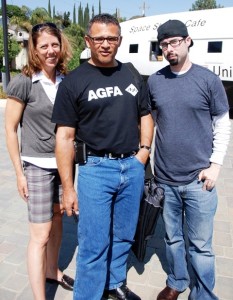 “I suggest you give Norm Riley a call,” Gallacher wrote Walsh September 1. “He can explain the process and most likely some of the hurdles that must be overcome to make this CAG a reality. Norms [sic] last day is this Thursday.”
“I suggest you give Norm Riley a call,” Gallacher wrote Walsh September 1. “He can explain the process and most likely some of the hurdles that must be overcome to make this CAG a reality. Norms [sic] last day is this Thursday.”
Riley was an enormously controversial DTSC supervisor for both the SSFL and Runkle Canyon properties. He was first greeted enthusiastically by the community as he seemed like a straight-shooter. That honeymoon did not last long as it soon appeared that Riley felt that the law passed to protect and cleanup SSFL, SB-990, was too strict and shouldn’t be applied.
Riley was canned August 19, 2009, just days before the publication of article where he was quoted as siding with Boeing’s contention that SB 990 was unnecessarily restrictive. A few weeks later, Riley attacked EnviroReporter.com in an e-mail which was covered in a September 15 post called “Riley’s Revenge.” Riley would return onto the scene in 2012 as a lobbyist for KB Homes long-delayed development in Runkle Canyon which was under DTSC’s purview as well as SSFL, meaning Riley’s control. [KB Home’s Runkle Canyon development is now called Arroyo Vista at the Woodlands.]
In fact, Riley was one of several Boeing allies who had also pushed for a community-replacing CAG, including a former Boeing employee and Boeing consultants Charlie Stringer and Tom Eisenhauser of Renewable Resources Group. In a March 15, 2009 e-mail to activist John Luker, Walsh wrote, “As far as Norm saying you should lead a CAG, as you might have noticed by the very recent letter signed by SIX ELECTED OFFICIALS, you were not the first or the last he hit up…. He apparently went to many with the CAG idea and it came back and bit him pretty good.”
The letter from elected officials that Walsh refers to was a March 9, 2009 letter to then Secretary of CAL EPA Linda Adams decrying Riley’s efforts to push for a CAG. “We cannot see how an issue this technically, legally, and politically complex, and with such a long and tangled history, including the involvement of the Federal District Court, could possibly lend itself to a CAG,” states the letter signed by Assemblywoman Julia Brownley, State Senator Fran Pavley, former State Senator Sheila Kuehl, Ventura County Supervisor Linda Parks, and Los Angeles City Councilmember Greig Smith.
Riley continued to push for a CAG that would replace the Work Group until his depature. In an November 2, 2009 e-mail to Walsh ally Mary Weisbrock, Riley suggested that instead of trying to get him reinstated, disgruntled community members put their energy toward a CAG that could counter the cleanup advocacy of the Work Group:
“I sincerely appreciate the support for my reinstatement voiced by you, Sue, Christina, Bill, Liz, and others; however, I must tell you that I do not think CalEPA or DTSC are paying serious attention to your requests, and I think it is extremely unlikely that they will ever ask me to return during this Administration. Perhaps it would be better if you were to focus your energies on the establishment of a Community Advisory Group (CAG) to replace the existing dysfunctional workgroup. A CAG would be superior to the workgroup in many respects and would create the possibility for technical assistance grants (funded by the RPs) to the CAG so that the community could have independent, qualified technical experts (selected by community members) advise on a range of relevant and important technical matters, and refute some of the nonsense excreted by current workgroup members.”
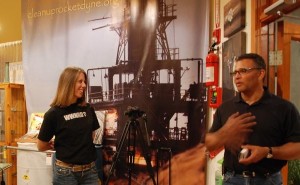 Walsh went ballistic with Riley’s removal and took to wearing “WWNRD?” black shirts standing for “What Would Norm Riley Do?” She kept her eye on the prize, however, as Boeing helped her negotiate her way to create a CAG. “Turning in 51 signatures today to petition a cag,” Walsh wrote Sams November 24, 2009.
Walsh went ballistic with Riley’s removal and took to wearing “WWNRD?” black shirts standing for “What Would Norm Riley Do?” She kept her eye on the prize, however, as Boeing helped her negotiate her way to create a CAG. “Turning in 51 signatures today to petition a cag,” Walsh wrote Sams November 24, 2009.
In March 2010, after receiving a counter-petition signed by over 200 people, DTSC denied Walsh’s CAG. Walsh’s on-again-off-again pal John Luker also refused to support the CAG in an e-mail he sent to DTSC and others in which he decried her hostile behavior:
“This is no longer about SSFL and the cleanup or even about the CAG… it’s all about Christina. She has made herself the center of attention and she’s basking in it,” Luker wrote, continuing that only a few people wanted a CAG and the rest had been, “threatened with legal action, insulted, yelled at, called names, received threatening email, told they should be fired or in some way bullied into silence.”
Related Material: “A Trail of Flames” & “A Keen Observer“
All of this disruptive and dangerous behavior is evidenced by an avalanche of e-mails, forum posts and threatening voice mails generated by Walsh. Even Bowling tired of Walsh’s tirades and antics, and separated from her in 2010 after she tried to blame the closing of ACME on Hirsch and others.
But instead of addressing the behavior or distancing itself, DTSC only coddled Walsh more, creating a “Public Participation Group” or PPG that operated much like a CAG. DTSC coordinated the PPG but was reimbursed by the responsible parties, who customarily reimburse DTSC for its efforts in remediating toxic sites.
Longtime SSFL activists found the PPG meetings unproductive and claimed PPG membership was stacked with cleanup opponents. Walsh wasn’t satisfied either, as she wanted Boeing, DOE, and NASA to be included as PPG members as well. The general public and media did not attend the PPG meetings, which were viewed as too technical in nature.
But the idea of a Boeing-funded CAG that could replace the Work Group was not dead. All Boeing needed to do was wait for a new state administration more friendly to its cause.
GARDEN OF EGO
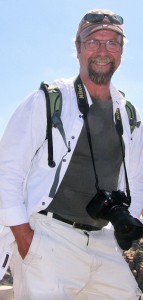 Boeing was also able to exploit the ambitions of San Fernando Valley resident John Luker. Luker is vice president of the Santa Susana Mountain Park Association, an organization whose mission is to “continue to preserve and protect habitats for plants and animals native to the location, unique geological formations, and sites of ethnological, archaeological, and historic interest.” While laudable, the group’s mission made it, and Luker, susceptible to the notion that Rocketdyne shouldn’t be cleaned up to background.
Boeing was also able to exploit the ambitions of San Fernando Valley resident John Luker. Luker is vice president of the Santa Susana Mountain Park Association, an organization whose mission is to “continue to preserve and protect habitats for plants and animals native to the location, unique geological formations, and sites of ethnological, archaeological, and historic interest.” While laudable, the group’s mission made it, and Luker, susceptible to the notion that Rocketdyne shouldn’t be cleaned up to background.
In a September 2010 email to Boeing, Luker asked for help checking for factual errors in copy accompanying a Flickr gallery of SSFL habitat that was going to be “stripped for short term political advantage” by the cleanup according to Luker. “I understand if some of you cannot comment, but, I wanted to make you all aware of what I’m going to be saying,” he wrote.
In a description for one photo, Luker wrote. “Just because there are constituents above background, does that mean this place is “Toxic”? Is it “Hazardous”? What exactly is the harm this place causes?” In another, he vowed to fight to the death to prevent a toxic spring from being remediated because it appeared beautiful. “This Plant is in the Southern Buffer Zone. In an Oak Riparian Woodland, right across the creek from a spring that is known to be seeping TCE. A phrase comes to mind… ‘Over my dead body!’”
Having been blind copied the e-mail, this reporter responded in a reply-all: “Are you saying that you would fight to the death over this lovely stream even though it may be impacted by TCE? Are you saying that the draft DTSC agreement with DOE and NASA is a grave mistake because one has more chance of getting cancer from driving on the 405 freeway than being at an unremediated SSFL? Are you suggesting that there be no cleanup, or at least no cleanup in these lovely spots?”
Luker did not respond though he has, from time to time, tried to engage me in hot story tips that he has never produced. His photos have since graced Boeing’s SSFL calendar and newsletter. Luker shares Boeing’s “vision for open space” and the curious contention that full remediation back to the way the lab was before being grossly contaminated would be worse than leaving the pollution in place.
But Luker’s motivation seemed to be as much about his status in the SSFL activist community as it was about what happens at the site. Early on, he was drawn to Walsh and Bowling for their leadership in the community as directors of the ACME facility. However, he was also hob-nobbing with Boeing, as a March 16 2009 e-mail from Walsh revealed. Walsh chided Luker for threatening her that he was “making side deals with Boeing” and telling her that if she wanted to know more she had better make him her (ACME’s) managing director.
Ultimately, in his quest for influence within the community, Luker set his sights on Dan Hirsch. In a February 2008 Ventura County Star article, Luker fawned over Hirsch “He is the most intelligent guy I have ever met,” said John Luker, a newer activist from Box Canyon. “You can’t underestimate him.”
“I’ve been talking to Dan,” Luker wrote in a March 16 , 2008 e-mail to Walsh, “and he is of the opinion that everyone needs to stop the hate.” This is ironic, considering the hostility Luker would later direct at Hirsch. In an April 2010 e-mail, Luker stated that no one in the community had the leadership skills to run a CAG “myself and Dan Hirsch included,” indicating he fancied himself in Hirsch’s league.
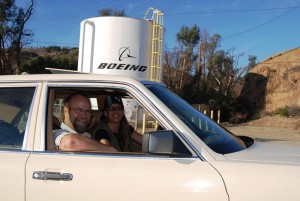 But Luker was trying to work both sides, and that could only last for so long. After he couldn’t talk Hirsch into going for lower cleanup standards, he went on the attack. He developed a fixation that became increasing obsessive and decidedly nasty.
But Luker was trying to work both sides, and that could only last for so long. After he couldn’t talk Hirsch into going for lower cleanup standards, he went on the attack. He developed a fixation that became increasing obsessive and decidedly nasty.
In a series of e-mails, Luker repeatedly attacked and interrogated Hirsch and demanded that he talk or meet with him. Luker also sent the messages to other members of the community, demanding that they make Hirsch talk to him.
The questions Luker demanded that Hirsch answer read more like a list of accusations, and absurd ones at that. He demanded that Hirsch prove he went to Harvard, to know who his “resource people” were and when he could meet with them (“I have been asking this question for 2 years and NEVER gotten an answer!” he exclaimed), how much money Hirsch made, if he was a registered lobbyist, if his students knew he does research for a private foundation, and more.
In one exchange, Luker berated Hirsch for “bullying the little old ladies you hide behind” and then forwarded the e-mail to the members of the Rocktdyne Cleanup Coalition, to whom he was referring, demanding that they answer his questions. Luker also gloated that he had been studying Hirsch for six years and it paid off as “important people” were now introducing him to legislators. “Why shouldn’t the Boeing Co make a profit off this cleanup?” he asked in an insult-laden e-mail to Hirsch that ended with an invitation to lunch.
The cumulative effect of this kind of behavior is that it disrupts the process that will lead finally to conclusion, cleanup. It does that primarily by just being offensive and harassing, which drives away multitudes of residents who live close to Rocketdyne, a process this reporter has witnessed since 1998. Typical community members just don’t want to deal with hostile people, let alone ones playing one-upmanship with each other and footsie with the polluter at the same time.
POWER PLAY
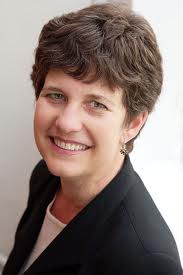 In January 2011, Governor Jerry Brown took office, appointing Matt Rodriquez as Secretary of Cal-EPA and Debbie Raphael as DTSC Director. For Boeing, things began to look up.
In January 2011, Governor Jerry Brown took office, appointing Matt Rodriquez as Secretary of Cal-EPA and Debbie Raphael as DTSC Director. For Boeing, things began to look up.
By this time, Walsh had grown to disparage SB 990, the state law she had once fought for, as well as the Agreements on Consent which required DOE and NASA to cleanup their portions of the site to background. She claimed that the Work Group did not represent her “needs as a community member” and became incensed when her request to make a presentation at a May 2011 Work Group meeting was declined. In addition, Walsh had managed to attract other disgruntled characters, some who were oddly enough completely new to the community yet opposed to both a full cleanup of the site and the Work Group.
Equally troubling were the disruptive tantrums that Walsh now threw regularly in meetings that even caused some community members to fear for their physical safety. These concerns were expressed to Raphael and other DTSC staff, who did nothing.
In October 2011, cleanup opponents sent a spate of nasty e-mails to DTSC demanding that Hirsch be removed from the Work Group and the panel membership be modified to include them. In response, DTSC cancelled the upcoming Work Group meeting. In January 2012, it cancelled the PPG meeting as well. The following month, DTSC cancelled another pending Work Group meeting and announced that the EPA would be ending its role as the facilitator and sponsor of the Work Group meetings, so it would be reviewing the needs of the entire community.
As months went on, the lack of meetings and failure to produce a new public participation plan created a void that Walsh used to reintroduce a CAG. On July 30, Walsh submitted a second online CAG petition, and the department immediately approved it.
This concerned longtime activists, as Walsh had previously been suspected of creating false identities to criticize cleanup activists on online forums and news websites. Indeed, evidence obtained by EnviroReporter.com shows Walsh assuming various online identities to attack community members viciously, even using one alias to claim she had cancer.
Related Material: “A Trail of Flames” & “A Keen Observer“
When the community members inquired about the CAG verification, Raphael confirmed in an August 3 e-mail that DTSC began working with Walsh on the CAG formation on the same day it received the petition, and that the petition “met the only legal requirement outlined in the law: it contained 50 or more signatures.”
But the law actually says otherwise – Cal. Health & Safety Code §25358.7.1.(a), states that the petition must be “signed by at least 50 members of a community affected by the response action at a site.” Many names on the online petition lived out of the area, some gave no last names, and the petition even included former DTSC staff-turned-KB Home-lobbyist Norm Riley and DTSC press contact Susan Callery. Further, the petition service, Signon.org, does not reveal any contact information to petition targets, so it would be impossible to verify that the signers were real people.
After DTSC received a letter from the Rocketdyne Cleanup Coalition’s attorney protesting the process, DTSC asked Walsh to turn in another petition.
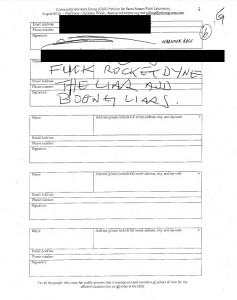
According to a letter from DTSC that Walsh also posted, DTSC’s verification procedure involved simply reviewing zip codes of the signers and approving the ones that were within five to ten miles of the site.
DTSC redacted the contact information for the signatures, so there is no way to independently verify that the petition is valid. Of course, blocking the document from public scrutiny only served to place the CAG – and DTSC – under further suspicion.
At the same time that Walsh was working to create a CAG, longtime community members were fighting to save the Work Group. DTSC and Cal-EPA provided many excuses for why the group couldn’t be continued, none of which held up to fact or reason.
At first, Debbie Raphael told the Work Group members that DTSC didn’t do “membership groups”, and that she had never heard of a group whose members continued in perpituity. But Raphael’s own External Advisory Group (EAG) is comprised of “environmental groups, representatives from Industry, and individuals from local communities” who are not democratically elected and who continue on the EAG in perpituity.
Last August, community members met with Miriam Ingenito, Assistant Deputy Secretary for Cal-EPA and were told that the state lacked the legal authority to convene the Work Group, and they should either ask the federal government to fund and convene the group or ask members of the legislature to provide DTSC the authority to convene the Work Group.
This, plainly put, is hogwash. No such statue is required, and since all DTSC’s remediation efforts including public participation are reimbursed by the responsible parties, it could, in fact re-establish the Work Group at no cost to the agency.
Finally, community members put up their own petition to bring back the Work Group, which was signed by over 200 people living near the lab in Los Angeles and Ventura counties. The petition also opposed a CAG, stating that, “A CAG is a discussion session to review and comment on DTSC response plans and is not an appropriate format for informing the general public in a clear and useful fashion about important developments involving the various agencies.”
Activists were also concerned that the run-around they were getting was further delaying the public from getting important information about the cleanup, specifically, the recent high radiation readings at the site. With no Work Group, there was no way for the public, press, or elected officials to find out about the new contamination data or compliance with the cleanup agreements. Perhaps, they worried, that was the point.
MISSION ACCOMPLISHED
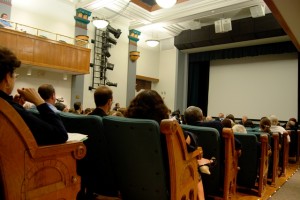
On September 21, the writing on the wall became an e-mail announcement from DTSC officially terminating the PPG and the Work Group and announcing that public participation for SSFL would be replaced by Walsh’s Boeing-funded CAG.
Though the announcement said that it had “decided to honor the wishes of a large portion of the community to continue the operation of the Interagency Workgroup,” it also made it clear that the Work Group that the public demanded – an operational, funded, Interagency Work Group – would be no more, to be replaced by a community-driven group that DTSC would have little to do with.
Longtime community members were outraged. In a September 24 letter, they expressed their betrayal to Raphael. “Ever since your appointment as Director, the Department of Toxic Substances Control (DTSC) has reversed course and taken numerous actions to undercut the cleanup and to do what Boeing, the company responsible for the pollution at the site, wishes.”
The community letter signed by 18 people also indicts the Brown Administration as well. “Boeing has purchased very powerful lobbyists and public relations consultants, including Winston Hickox, Peter Weiner, Bob Hoffman, Charlie Stringer, and Gary Polakovic, several of whom are close to the Governor. We recognize that we represent merely the “little people,” everyday folks who live near this polluted facility, whose families face the risk of cancer and other ailments from the decades during which Boeing and its predecessors have succeeded in avoiding cleanup obligations. Your actions indicate to us that in your eyes we don’t count, that it is only the powerful like Boeing that matter, that you will do what they want you to, no matter who among the unpowerful gets hurt by it.”
Not surprisingly, and without a hint of irony, Luker, Walsh, and others they recruited wrote Raphael a rebuttal letter September 26 decrying being exposed as being a “fake, grass-roots” astroturf group to “lobby for the polluter.”
“Our group represents the evolving view of the local community,” the letter says, even as hundreds of locals concerned about the cleanup oppose the Boeing SSFL CAG. “We represent a growing constituency of community members who believe in a reasonable, science-based approach to the clean-up. We want to see action continue to move forward on the clean-up, not to have it become entangled in politics and a culture of fear for another 22 years.”
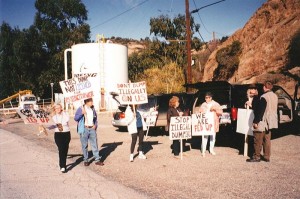 The so-called “reasonable, science-based approach” reflects the Boeing-inspired contention that cleaning up Rocketdyne back to normal is too great a task and would mar the otherwise scenic site – even though much of the contaminated soil is in already disturbed areas, not pristine wilderness. Longtime activists say 95% of the contaminated land would not be taken to a licensed dump for chemically or radiologically contaminated dirt, concrete, asphalt and an array of materials that sit outside in the elements at Rocketdyne.
The so-called “reasonable, science-based approach” reflects the Boeing-inspired contention that cleaning up Rocketdyne back to normal is too great a task and would mar the otherwise scenic site – even though much of the contaminated soil is in already disturbed areas, not pristine wilderness. Longtime activists say 95% of the contaminated land would not be taken to a licensed dump for chemically or radiologically contaminated dirt, concrete, asphalt and an array of materials that sit outside in the elements at Rocketdyne.
Luker also seemed quick to forget that his once-again ally Walsh, according to his own claims, threatened to kill him as he spins this “culture of fear” blamed on the Hirsch without any evidence.
Longtime community activist and Work Group panel member Barbara Johnson is appalled. “I see that Professor Daniel Hirsch, as a true American hero who has so unselfishly given of his time and expertise to the long, difficult effort to see that, first, all nuclear work was ceased, and second, that extensive efforts were put into cleaning up this heavily polluted site. Thus, I cannot understand why today Mr. Hirsch is being vilified by those who came after him. Don’t these people, who only want to satisfy their own personal ambitions for the resolution of the sprawling property, recognize that the facility would be nuclear business as usual without the efforts and tenaciousness of Mr. Hirsch?”
Local activist Marge Brown is equally concerned. “It is devastatingly unfair and unjust that Dan should be attacked, and, for the sake of a complete radioactive and toxic chemical cleanup, we need to make sure that these attacks do not succeed…the attackers also appear to be quite willing to leave a thousand times more contamination in the soil, as well.”
A team of six DTSC came with their own kind of shovels to a meeting with members of the SSFL Work Group October 25. DTSC said it would come to only two Work Group meetings a year, that is if the volunteer members could manage to even find a place to meet since the department would provide no funds.
The DTSC hit squad explained that what the community really needs is a CAG free from the strings of the government. The department seemed to be going over and above the call of duty to assist Walsh, however, when the it debuted its membership application for Boeing’s SSFL CAG on November 16, stating that DTSC, not Walsh, is soliciting members.
DTSC also revealed that it would be spending $5,000 on a “mediator” to get the CAG going, funds that would have paid for the renting of a hall for the quarterly Work Group meetings for a year and a half. In addition, the agency also paid $1,398.80 for newspaper ads in the Daily News, Ventura County Star, and the ACORN, according to Charlotte Fadipe, DTSC chief of media and press relations, in a November 29 e-mail. These expenses are supposed to be reimbursed by the responsible parties at SSFL.
Perhaps the worst insult added to a list of injuries from DTSC was its refusal to even let the Work Group have its own mailing list back and and to put out notices for any future meetings.
Without the list, it would be impossible to notify the hundreds of attendees who filled the Work Group’s venue, the Simi Valley Cultural Center, shown in this 2006 news segment to the left which featured a study by the SSFL Advisory Panel on health effects from the 1959 meltdown.
On November 30, DTSC’s Fedipe explained denying the Work Group their own list in an e-mail to EnviroReporter.com:
“In a meeting held between DTSC and the Workgroup, on October 25th, DTSC Public Participation staff was asked to handover a copy of its SSFL Workgroup email list. Our staff informed the Workgroup that we were unaware of whether the mail list had been transferred to DTSC, or whether it would be considered the Workgroup’s mailing list. We informed them we would follow up with EPA with those questions. As a result we learned that DTSC was provided the mailing list. However, when EPA shared the mailing list with DTSC, it was with the understanding that they were transferring the information to another governmental agency. EPA expressly stated that they would not have consented to release the information to the general public.”
But Work Group members say that is not what happened. They say that DTSC claimed it didn’t have the list and would check and get back with them. It was only through an interview with EnviroReporter.com that the Work Group learned about the status of their request. Members were also taken back to be referred to as “the general public” instead of Work Group members, which they interpreted as a sign of DTSC’s disregard for them.
DTSC’s November 16 announcement states that the SSFL CAG membership will be “reviewed and considered by a Selection Panel in early 2013.” Once DTSC is done helping establish the CAG, the CAG must seek it’s own funding. That will presumably come from Boeing, given Walsh’s early exchanges with Boeing about funding the CAG.
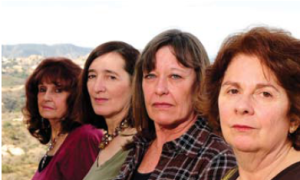 Rocketdyne Cleanup Coalition Marie Mason expressed betrayal and disappointment. “It is clear to me that DTSC wants us out of the picture and wants the Work Group to end so we have no public place to hold their feet to the fire. Those of us who have worked for over 20 years have been just kicked to the curb.”
Rocketdyne Cleanup Coalition Marie Mason expressed betrayal and disappointment. “It is clear to me that DTSC wants us out of the picture and wants the Work Group to end so we have no public place to hold their feet to the fire. Those of us who have worked for over 20 years have been just kicked to the curb.”
Mason added that, “The Boeing funded CAG will just be a press on a group of people most of who think they are really helping see the place get cleaned up but since it’s so complicated they will be talked into doing what Boeing wants done and that’s no clean up. The community will lose and that makes me really sad since we were so very close to a real clean up. I want no part in this Boeing charade, if they are paying for this group I’m sure they will want to get their money’s worth.”
These are the darkest days of the fight to clean up Rocketdyne thanks in great part to the coordination between Boeing, DTSC and these third-party allies like Walsh and Luker. In the two years since Governor Jerry Brown took office, the department has done more to isolate and eliminate cleanup activists than has happened at any other time in the 23 years the Rocketdyne Cleanup Coalition has been fighting for full remediation of SSFL.
But don’t count them out. “We will continue to fight for cleanup,” community members wrote in their September 24 letter to Raphael. “We fought long before you became Director, and we will keep fighting long after you cease being Director.”
Related Material: “A Trail of Flames” & “A Keen Observer“
NEXT: PART FOUR – TOXIC DEPARTMENT
27 Years of Award-Winning SSFL/Rocketdyne Reporting
1998 – 2025













Does anyone recognize any of the names of the people chosen to be on the CAG selection committee? See http://groups.yahoo.com/group/ssflcag/message/2190 I don’t think any of these people have been involved before except Walsh and Karchem who is new but gives cleanup advocates a hard time. I googled them all and see no history with SSFL whatsoever. One of them signed the CAG petition but is described as neutral? And another specializes in archaeology concerned with “protecting cultural heritage” so clearly in favor of the pollution park people. Another the “occidental petroleum chair” in chemistry with bad reviews by students at ratemyprofessors.com who say he gets mad at those who disagree with him. Another represents Chumash who seem more interested in getting the property and than clean up. So this group of strangers never involved before will pick who will be on the CAG meaning more like themselves easily fooled by Boeing DTSC etc. Seems to be the perfect group of “third parties” that Gary Polakovic wants to help Boeing avoid charges of greenwashing as his plan says. What a sham!!! The Udall Institute should be ashamed too and also I wonder who the CAG will get to fund the “neutral facilitator? To me this confirms points made in this article that the whole idea of the CAG was to get rid of one community and replace it with another one that isn’t a community at all. Meanwhile children in the community are exposed to all of the poisons from the lab but don’t worry they will commission a blue ribbon study to say its all ok nothing to see here move along.
Thank you for this excellent expose. I got a CAG application in the mail. No thanks I want no part in Boeing’s group. I support the old-timers – thank you for your dedication do not give up! It is worth it for the safety of our community.
How do I feel about astroturfing and the mean-spirited nature of these nasty schemes? AAARRRRGGGGGHHHHHHH! Boeing and its co-conspirators have spent a lot of time planning how to undercut and destroy their critics and no time whatsoever on cleaning up the mess on their property. They prefer to save money and SUE the state. Someone cleaned up on that one.
Wow, these Boeing guys are thorough. They’re getting good advice from their media and astroturf consultants, and they’re following it. Boeing’s going to assert over and over that they’re on the side of the angels, and casual observers will begin to believe them.
This is depressing reading. Boeing is rich and persistent, and a number of folks in this story have clearly and simply been BOUGHT.
Michael,
Your incredible recording of all the events,emails, personalities, changes of alliances, and financial support by Boeing in this article make me feel like Alice, who fell down the rabbit hole into insanity. But then, poor Alice probably would have been wiped out by some Cesium 137 or some toxic chemicals.
Thank goodness that you have been keeping track of all of this madness. This article has absolutely made my whole year! I didn’t realize how bad things have been until I read it. Please keep up your good work. I don’t see how things could possibly get any worse.